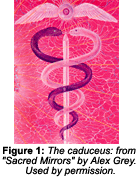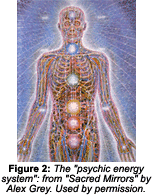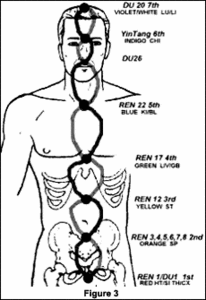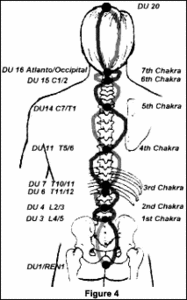It is estimated that 61% of patients with CTS avoid taking surgical options due to postoperative complications and costly surgical procedures. Chiropractic care offers a comprehensive and effective treatment for carpal tunnel syndrome, addressing the condition from multiple angles. Recent studies also have unveiled a game-changing adjunct to chiropractic treatments for CTS: nerve flossing.
The Caduceus, Chakras, Acupuncture and Healing, Part I
Practitioners undoubtedly recognize the illustration in Figure 1 as the caduceus, the internationally accepted symbol of medicine. Even though it is universally associated with the modern medical profession, its use has ancient derivatives. The caduceus has much more meaning to the professions of acupuncture and chiropractic than allopathic medicine. Understanding the close relationship of the ancient Sanskrit meaning of the caduceus to these two dynamic professions may be one of the most significant healing revelations in a practitioner's career.
In Greek mythology, Hermes (Mercury) was known, among other duties, as the messenger and deliverer of information. The staff of Hermes, with the double-coiled serpent around it, became the symbol adopted by 17th-century printers, also the deliverers of messages.

In the 19th century, a well-known U.S. medical publisher began displaying the caduceus prominently on its textbooks. These published medical textbooks established an association between medicine and the caduceus. When the U.S. Army Medical Corps adopted the caduceus in 1902, replacing its cross logo, it became firmly implanted as the symbol of medicine, replacing its earlier representation of communication and wisdom.
Hermes was also known as the deliverer of the souls of the departed to the underworld, and as the patron of thieves - yet in the Greek myths, he is often associated with wealth and business. Many medical physicians over the years have been less-than-accepting of the caduceus as a symbol of medicine, believing its relationship with Hermes conferred an association with death, trickery and the accumulation of wealth. Establishments such as the American Medical Association and Blue Cross/Blue Shield have adopted the staff of Aesculapius, a single snake coiled around a cypress branch. This was done possibly to distance itself from the double snake caduceus of Hermes, and because of its historic significance to healing, according to Greek mythology.
Also in Greek mythology, the god Apollo killed his unfaithful mortal mistress Coronis in a jealous rage. When Apollo realized Coronis was pregnant with his son, he called upon Hermes to deliver the child while her body lay on the funeral pyre. The child was Aesculapius.
Chiron, the wise centaur and healer (who arguably has a connection with chiropractic in name only) was called to school Aesculapius in healing, since Chiron's father, Apollo, was the god of health. Eventually, Chiron became the god of medicine, complete with his own cult, temples and rituals. Hippocrates, the father of western medicine, was a 20th-generation member of the cult of Aesculapius.

Various explanations throughout history suggest the staff of Aesculapius represents rebirth, through the snake coiled around the staff; and strength, as symbolized by the cypress branch. Hermes allegedly received the double snake on the staff as his symbol while he was delivering an enlightened message. On the way, he came across two snakes fighting and struggling with one another; when he placed a stick between them to separate them, they stopped fighting while they coiled around the staff. It is unclear how this symbol became associated with Hermes.
Throughout religious and mythical history, serpents and staffs have always had a close association, as have symbols of serpents and birds. The origin of Kung fu refers to a folktale of a Buddhist monk (some versions say a nun) who observed a crane fighting a snake and designed exercises to emulate their motions. In Buddhist folklore, Buddha once meditated under the tree of the serpent king. When a rainstorm threatened to drench Buddha, a giant cobra wrapped himself around him seven times and opened its hood to keep him dry.
The pharaohs of ancient Egypt wore the trademark of the vulture and the cobra. The coiled serpent, worn on their foreheads, represented divine fire that originated at the base of the spine and ascended toward the head. This represents the kundalini (energy system), illustrated by the coiled snake coursing up the spine.
In the medical practices of India and southern Asia, the kundalini has been represented for centuries by double-coiled snakes coursing up a single staff, as shown in Figure 1. This has absolutely no relationship to Hermes and Greek myth. It has been said that the philosophy of India and Southwest Asia (to include Thailand) preceded Greek legend by as much as 1,000 years. The double serpent on the staff was solely a representation of the kundalini coursing up the body, from the perineum and sacrum to the crown of the head. This symbol has extremely important correspondences to both acupuncture and chiropractic, particularly when utilized and practiced in a therapeutic sense.
The two snakes are representations of the spinal tracts known as the ida and the pingala. The ida is the yin energy (negative), whereas the pingala is yang (positive). These two snakes are coiled around what is referred to as the sushumna, or main spinal tract or cord. Each occasion in which the two snakes cross each other as they entwine, coiling up the body, represents the location of a chakra . Chakras are the primary centers of electromagnetic energy in the body. The crossing of the serpents occurs seven times - thus the seven chakras. In actuality, the wings at the top of the staff represent the seventh chakra. Ren 26, although not an official chakra, plays an extremely important role in chakra healing.
The illustration of the chakra and acupuncture meridian system (Figure 2), from Alex Grey's classic Sacred Mirrors, may be one of the most accurate representations of the energy system ever illustrated in acupuncture's long history. Very little, if anything, is ever mentioned of the chakra system in either ancient or contemporary Chinese acupuncture texts; however, it is mentioned often in master-to-student education, especially through Southwest and Southeast Asia. It was in Southwestern Asia, around the borders of Tibet, where I was first introduced to this concept, and later in Cambodia and Thailand.
The chakras have been described as where the qi energy circulating throughout the meridian system originates. It takes air, food, water and sensory and intellectual stimuli to manufacture and replenish qi. The chakras are responsible for meridian energy distribution; they are of incredible significance in healing, as they are the primary electromagnetic energy system of the body.
The individual circular rotations of the chakras are associated with specific frequencies, measured through color and sound. The colors associated with the "five elements" have specific relationships to each of the chakras. Consequently, blue, associated with the fifth chakra at Ren 22, has a specific relationship with the "water" element, namely the "bladder" and "kidney" acupoints, whereas the fourth chakra, associated with the color and frequency of green, located at the sternum at Ren 17, obviously is associated with the "wood" element or the "liver" and "gallbladder" acupoints.
One of the most significant healing factors of chakras is simply the fact their electromagnetic energy is located not on the anterior of the body, as they are generally illustrated, but in the middle of the body. They also communicate to both the front and back: yin and yang. This spinal connection may explain many of the almost miraculous clinical results reported throughout the history of chiropractic, as DCs adjust these critical areas of the spine where the chakras communicate to the posterior intervertebrally. Acupuncturists worldwide likewise utilize these important therapeutic acupuncture points frequently in treatment, with stunning success.


The number of severe and disabling health conditions that may be treated based on awareness of the meridian system and the chakras has few equals throughout the healing professions. It is truly incredible. When one develops an awareness of the caduceus, the chakras and specific acupoints, along with the knowledge gained from electromeridian imaging (EMI) diagnosis, as reported in previous issues, it creates an entirely new dimension of clinical response in conventional acupuncture.
The two illustrations on this page (Figures 3 and 4) show the relationship of the chakras to the ida and the pingala, and their relationship to specific landmark acupuncture points. Many conclusions be drawn as to application by practitioners reading this article. Many will report literally outrageous clinical results. (Because of space limitations, I cannot fully describe the clinical applications of this work until part II of this column!)
Clip out, save and study Figures 3 and 4, and realize a picture truly is worth a thousand words. Compare the double-coiled serpent on the staff in the caduceus to the trajectory of the kundalini and qi systems of the body. Relate this entire concept to the chakra system in Figure 2. You will be delighted at what will be revealed to you by simply studying this chart. I will expound on clinical applications in my next article. These charts will not be reprinted in the next article, so be sure to save these for reference when reading part II.
I will be presenting a special program on EMI, along with the relationship to the charkas, at the Acupuncture and Oriental Medicine Alliance 10th Annual Conference and Expo in Safety Harbor (Tampa), Fla., May 2-5. Watch for announcements or drop me a line for the schedule. See you there!
John Amaro, DC, FIAMA, Dipl. Ac, LAc
Carefree, Arizona
phoenixdragon@fiestanet.com



